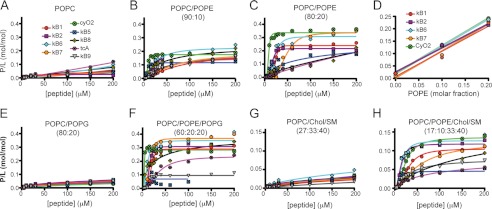FIGURE 2.
Membrane binding of cyclotides requires PE-phospholipids. The membrane binding activity of selected cyclotides was monitored by SPR. The peptide-to-lipid ratio (P/L mol/mol) at the end of peptide injection was calculated to normalize the response to the total amount of lipid deposited on the chip and to the amount of peptide that binds to the lipid bilayer (1 RU = 1 pg·mm−2 of peptide or lipid). P/L was plotted versus peptide concentration, and the curves were fitted with a nonlinear regression equation, dose-response binding with Hill slope (see Table 2 for fitting parameters). Binding of cyclotides with membranes comprising different lipid mixtures is as follows. A, POPC; B, POPC/POPE (90:10 molar ratio); C, POPC/POPE (80:20); E, POPC/POPG (80:20); F, POPC/POPE/POPG (60:20:20); G, POPC/Chol/SM (27:33:40), and H, POPC/POPE/Chol/SM (17:10:33:40). D shows the correlation between the P/L and the fraction of PE in the membrane when POPC, POPC/POPE (90:10) and POPC/POPE (80:20) membranes are compared. Cyclotides belonging to the Möbius subfamily and cyO2 are represented at a fixed peptide concentration close to the determined Kd value, and the slope of the plots are as follows: 1.01 ± 0.22 for kB1, 0.97 ± 0.03 for kB2, 1.08 ± 0.02 for kB6, 1.09 ± 0.14 for kB7, and 1.11 ± 0.00 for cyO2, suggesting that these cyclotides have a 1:1 stoichiometry binding to PE-phospholipids when in a fluid membrane.

